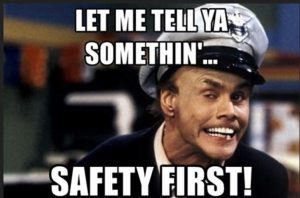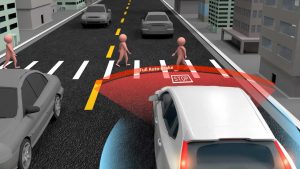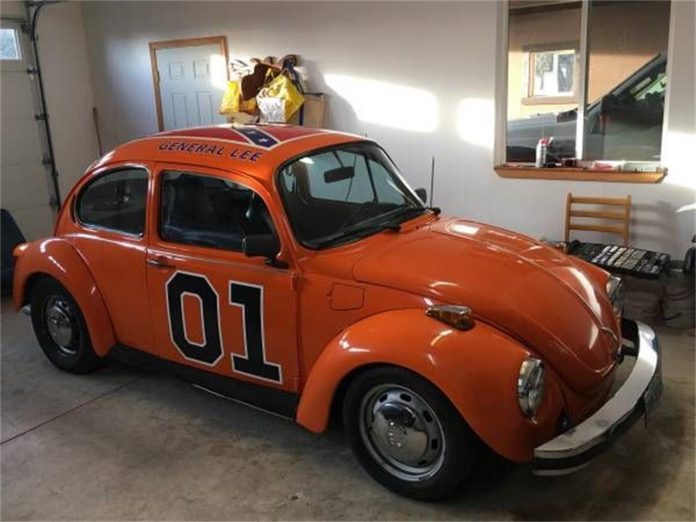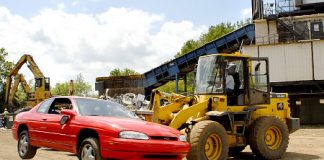Many people want what is styled a “safe” car – and the government panders to this fear by implying that any car that does not comply with the latest “safety” standards it gins up (and which raise the price of the car, as well as adds to its curb weight, which raises the cost to fuel it) is not “safe.”
Logically, this means every car made before the latest round of “safety” standards is not “safe” since it does not comply with the very latest “safety” standards. It would also for that reason be illegal to sell today.
But what does “unsafe” mean, actually?
In general usage, it is taken as being synonymous with dangerous. How so, again? Does it mean a given car is unstable? More likely to crash because of a design flaw that causes it to handle or react erratically? In that case, the car can accurately be described as dangerous – as “unsafe.”
But very few such cars have ever been made. Poorly made ones, surely. But even notoriously “unsafe” cars like the first-generation Corvair and the Ford Explorer of the ’90s were only unsafe if their drivers made them so by not maintaining correct tire pressure and then driving them recklessly.
When most people talk about “safety” – and whenever government bureaucrats and politicians use the word – they mean a car’s compliance or not with the latest (and all previous) “safety” standards, including those intended to Band Aid reckless/inattentive/incompetent driving. 
This is a qualitatively different thing.
The standards are about crashworthiness, i.e., a given car’s ability to lessen or prevent injury to its occupants in the event of a crash. This begs a question worth asking about crashes – and what it means in terms of “safety” if a crash doesn’t happen.
Consider two extremes on the spectrum in terms of their crashworthiness and so their “safety” –
On the one hand, a full-sized (and brand-new, compliant with every current “safety” standard) pick-up truck like the 2021 Ford F-150. It is huge and hulking and very “safe” indeed, if you wreck.
On the other hand, a small car like the 1974 VW Beetle I drove every day for many years during college and afterward that complied with none of the currently-in-force “safety” standards – and which for that reason cannot be purchased new today.
Obviously, the VW would not have protected me as well as the new Ford if I crashed it. But does that mean the Beetle was “unsafe” to drive? If it was, how come I was never injured in it despite having driven it every day, for many years? If it was an “unsafe” to drive car – and by the standard of government-speak, it was – I should have been injured at some point.
But the car wasn’t unstable – i.e., prone to crash – so it didn’t. I was competent, too – which helped. It was just as safe to drive in terms of my not being injured as the new F-150 so long as I drove it attentively and competently and thereby avoided crashing it.
There may have been a higher abstract risk of potential injury or even death in the event of a crash involving the VW but these are are hypotheticals while the fact is the car was no more dangerous to drive than the new Ford I test drove recently, since I walked away without a scratch after driving both of them.
My old VW was also “safer” – in terms of its ability to protect occupants in the event of a crash – than a brand-new motorcycle. 
This is inarguable.
Yet it is still perfectly legal to buy an “unsafe” motorcycle without things like air bags and back-up cameras, etc. – i.e., one that does not comply with all the “safety” standards applicable to cars and which, therefore, is by definition “unsafe.”
Some will say it’s apples and oranges – but not if the standard for “safety” defined as complying with the various government standards regarding occupant protection in the event of a crash.
You either is – or you isn’t.
So why are motorcycles allowed to be sold without air bags and so on while it is not allowed to sell a fundamentally safer (i.e., more crashworthy) new car without them?
The answer, of course, is that motorcycles predate the government’s somehow-found power to mandate car “safety” and – unlike cars – cannot be made to comply with the various “safety” standards and still be motorcycles. It would be necessary to enclose them, for instance – at which point they would be cars. For the moment, there is too much likely resistance to making motorcycles “safe” like cars.
Regardless, this “safety” business – as defined by the government – isn’t an actual but a possible.
And to a very great extent, an avoidable.
The possibility of crashing – and thus, of being injured or killed – can be reduced to a very acceptable level no matter what you’re driving (or riding) by attentive and skillful driving and riding.
The proof of which lies in the fact that millions of other people also drove cars like the old Beetle I once drove without ever being injured as a result – as well as the fact that millions of people are driving around right now in older cars and brand-new motorcycles that are “unsafe” in the regulatory-speak sense – as they do not “comply” with the latest “safety” standards
But it does not mean they are unsafe. It only means they are not compliant.
The cost of “safety,” on the other hand, is unavoidable.
It can be measured in monetary as well as other terms, such as the loss of freedom of choice – including the choices involved in weighing risk vs. reward.
You must pay for every “safety” standard imposed by the government on new cars, which comes at the cost of your freedom to drive a less expensive, simpler, lighter and so more fuel-efficient car, among other things.
Things which benefit you in real ways every day – as opposed to the possible benefit of a “safer” car that’s no more dangerous to drive than my old Beetle.
So long as you avoid crashing it.
. . .
Got a question about cars, Libertarian politics – or anything else? Click on the “ask Eric” link and send ’em in!
If you like what you’ve found here please consider supporting EPautos.
We depend on you to keep the wheels turning!
Our donate button is here.
If you prefer not to use PayPal, our mailing address is:
EPautos
721 Hummingbird Lane SE
Copper Hill, VA 24079
PS: Get an EPautos magnet or sticker or coaster in return for a $20 or more one-time donation or a $10 or more monthly recurring donation. (Please be sure to tell us you want a magnet or sticker or coaster – and also, provide an address, so we know where to mail the thing!)
My eBook about car buying (new and used) is also available for your favorite price – free! Click here. If that fails, email me at EPeters952@yahoo.com and I will send you a copy directly!













Any vehicle is only as “safe” as its driver.
Sure, we can get a vehicle that’s in effect a Panzerkampfwagen Konigstiger Ausf B with chrome and hubcaps…oh, waitaminnit, that was a 1974 Mercury Marquis! Seriously, some 45 to 55 years ago, most American “full size” sedans were like main battle tanks in comparison to today’s “iron”. I recall on the 1973 models that a big ballyhoo was made regarding the “5 mph” bumper. Now, were folks getting hurt in these “fender menders?”. I doubt it, but the bottom line of the insurance mafia was. All was fine…VERY briefly, as along came the 1973 “gas shortage”, and suddenly it mattered more to have small, lightweight cars…back when you could GET one.
Ralph Nader is an example of a shyster, and in his case, not a very good one, who reinvented himself as an “advocate”, mainly to get rich off writing books and doing the rubber chicken circuit. The man, who was about thirty when “Unsafe At Any Speed” was initially published, didn’t even have a car or a driver’s license, and, AFAIK, never has. A classic case of an “academic” who has ZERO practical experience nonetheless finding a forum to have influence well beyond what he reasonably ought to have.
The safety cultists are socialists/communists. They want their level of safety to be spread out over everyone’s personal costs. They define their “need” and require from everyone’s “ability to pay.”
What would be their personal cost for the preference even if available if not subsidized by everyone else.
From each according to his abilities to each according to his needs. Where did we read that?
The problem is that one cannot force people to work or work above a certain level or even consume (buy new cars) without herculean effort with mixed results.
Hence the asset inflation and ownership and use taxes.
Not going to be a pretty fight.
PJ O’Rourke wrote that America wouldn’t fall to Marxism in a huge last battle but incrementally with *Safety First* as it’s motto.
Hi Hans,
Yup; I was reading PJ back in high school and college. He’s fallen off the radar lately – or seems to have.
My fave from that talented writer…
https://www.amazon.com/gp/product/B008UX8K3S/ref=dbs_a_def_rwt_bibl_vppi_i2
Eventually we’ll end up in a situation like airplanes. 99% of the accidents today are attributed to “pilot error” unless overwhelming evidence proves otherwise. And this is what industry wants. Plug up all the holes and all that will be left is “it’s the driver’s fault,” and everyone else gets off the hook. For sure the highway department is blameless for everything already, even if the roads are turning to dust before our eyes.
Of course we started with “driver at fault” in the beginning but over time lawyers and laws made that an impossible standard to prove in court. Ultimately it always is the driver’s fault, since a vehicle sitting in the garage probably isn’t going to crash into anything.
If I am riding a bicycle with no helmet on the road I should have died already.
I still miss my 1974 Peugeot 504: First car I ever owned. THAT was a proper little iron box, and had a fully mechanical diesel engine to boot. Wish I still had ‘er.
That car seemed VERY safety, though I’m sure it would fail by every measure of today’s standards, which seem to require every car to crush like aluminum foil on impact.
Yeah, the most unsafe thing about that car, back then, was the youthful and chaotic driver. 😉
We could make extremely safe cars and save the environment at the same time.
Make all cars on NASCAR chassis. Infinitely rebuild-able and reasonably safe in a 200mph crash.
No ‘new models’ or brands, just a ‘maker’ paint job. Works for NASCAR.
‘You must pay for every “safety” standard imposed by the government on new cars, which comes at the cost of your freedom …’ — EP
Where I used to live in an old New York village that saw its heyday in the late 19th century era of steam-powered locomotives with their lonesome whistles in the night, some old Victorian houses remained.
The ever-escalating demands of modern building codes apply in every particular to new houses. But most new requirements aren’t imposed retroactively on old houses, unless major renovations are done or the house is sold — in which case a horrid east coast invention, the certificate of continuing occupancy, can cost thousands for upgrades.
Nevertheless, people living in ancient abodes with horsehair plaster-on-lath walls, wavy-glass windows, lead pipes for plumbing, and crappy old resin-impregnated cloth wiring from electrical upgrades in the 1930s don’t die at significantly higher rates than those living in state-of-the-code 2020 residences.
Old houses, old cars, old barns: these are the natural habitats of bitter clingers.
MOLON LABE, effers.
A “certificate of continuing occupancy” sounds like a most disagreeable requirement.
As we march ever onward to the perfect world, were we don’t ever suffer the consequences of our mistakes and stupidity. After all, why should I be injured in a car crash that was the result of me putting on make up while driving, or because I was gawking at a scantily clad very nice looking young woman? Gimme armored vehicles. Since I prefer not to take care of myself, why should I suffer ill health? Gimme vaccine. To quote one of the greatest intellects in the world, “You can’t fix stupid”.
Sheeez John I hope you are not putting on makeup while driving. That is girl’s stuff, and I have seen many instances of that along with the gal who kept combing her hair while highway driving with the top down.